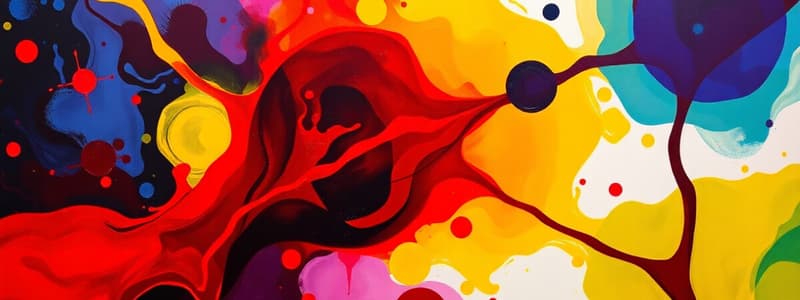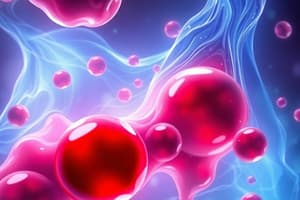Podcast
Questions and Answers
Which plasma protein is primarily responsible for transporting iron in the blood?
Which plasma protein is primarily responsible for transporting iron in the blood?
- Albumins
- Globulins
- Fibrinogens
- Transferrin (correct)
What is the primary function of red blood cells (RBCs)?
What is the primary function of red blood cells (RBCs)?
- Transport of oxygen and CO2 (correct)
- Immune defense
- Formation of clotting factors
- Transport of nutrients
What is the first step of hemostasis?
What is the first step of hemostasis?
- Coagulation
- Vasoconstriction (correct)
- Fibrinolysis
- Platelet plug formation
Which process describes the production of white blood cells (WBCs)?
Which process describes the production of white blood cells (WBCs)?
Which cytokine is primarily involved in the production of platelets?
Which cytokine is primarily involved in the production of platelets?
What essential role do platelets play in the body?
What essential role do platelets play in the body?
What is the primary role of albumins in plasma?
What is the primary role of albumins in plasma?
Which sequence accurately aligns the processes of blood cell production?
Which sequence accurately aligns the processes of blood cell production?
What converts fibrinogen into fibrin during coagulation?
What converts fibrinogen into fibrin during coagulation?
Which of the following describes the substance necessary to dissolve a blood clot during fibrinolysis?
Which of the following describes the substance necessary to dissolve a blood clot during fibrinolysis?
Flashcards
Plasma
Plasma
The liquid matrix of blood, primarily composed of water and dissolved substances like proteins, ions, organic molecules, and gases.
Albumin
Albumin
A major plasma protein that contributes to blood's osmotic pressure, helping to regulate fluid balance, and acts as a carrier for various substances.
Globulin
Globulin
A diverse group of plasma proteins with varied functions, including clotting factors, enzymes, antibodies, and carriers.
Fibrinogen
Fibrinogen
Signup and view all the flashcards
Hematopoiesis
Hematopoiesis
Signup and view all the flashcards
Erythropoiesis
Erythropoiesis
Signup and view all the flashcards
Leukopoiesis
Leukopoiesis
Signup and view all the flashcards
Thrombopoiesis
Thrombopoiesis
Signup and view all the flashcards
Platelets
Platelets
Signup and view all the flashcards
Hemostasis
Hemostasis
Signup and view all the flashcards
Study Notes
Blood Composition and Functions
- Plasma is the liquid matrix of blood, primarily composed of water and dissolved substances like proteins, ions, and organic molecules.
- Major plasma proteins include:
- Albumins: Contribute to osmotic pressure and transport substances.
- Globulins: Involved in clotting, enzymes, and transporting substances.
- Fibrinogens: Essential for blood clotting.
- Transferrin: Transports iron.
Cellular Elements of Blood
- Red blood cells (RBCs): Transport oxygen and carbon dioxide.
- White blood cells (WBCs): Crucial for immune defense.
- Platelets: Cell fragments essential for blood clotting.
Hematopoiesis
- Hematopoiesis is the production of blood cells, occurring in the bone marrow.
- Subtypes include:
- Erythropoiesis (RBC production).
- Leukopoiesis (WBC production).
- Thrombopoiesis (platelet production).
- Key cytokines involved in hematopoiesis include erythropoietin (EPO), thrombopoietin (TPO), colony-stimulating factors (CSFs), and interleukins.
Platelets
- Platelets are involved in stopping blood loss, immunity, and inflammation.
- They form a primary plug at the site of wound.
- Their structure and function are essential during coagulation and fibrinolysis.
Hemostasis, Coagulation, and Fibrinolysis
- Hemostasis is the process of stopping bleeding.
- Coagulation is the process of forming a blood clot involving various steps, including a cascade of chemical reactions.
- Fibrinolysis is the enzymatic breakdown of the clot to restore normal blood flow.
- Thrombin converts fibrinogen into fibrin
- A blood clot is formed (reinforced by platelets)
- Fibrin is dissolved by plasmin.
- The above steps involve factors like platelets, plasminogen, tissue plasminogen activator (tPA) and fibrin.
Studying That Suits You
Use AI to generate personalized quizzes and flashcards to suit your learning preferences.




